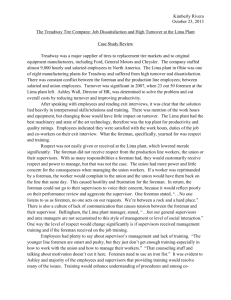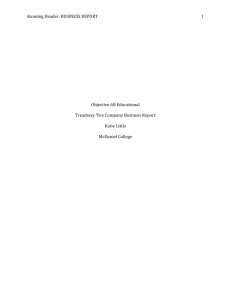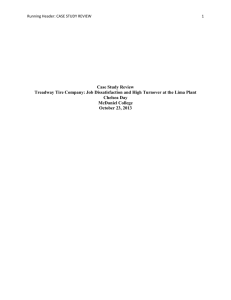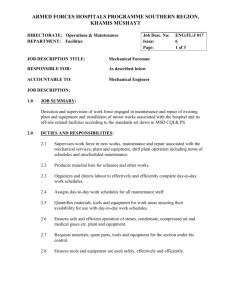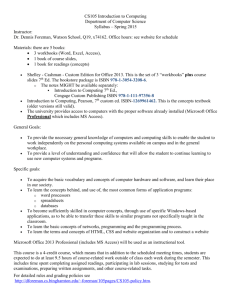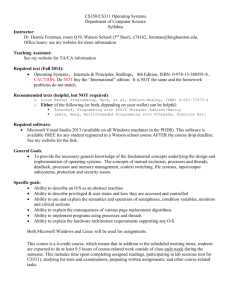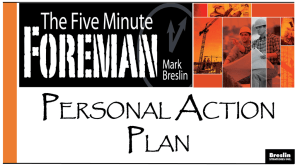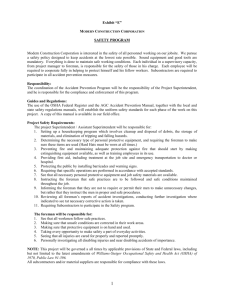Running Head: Business Report Business Report Treadway Tire
advertisement
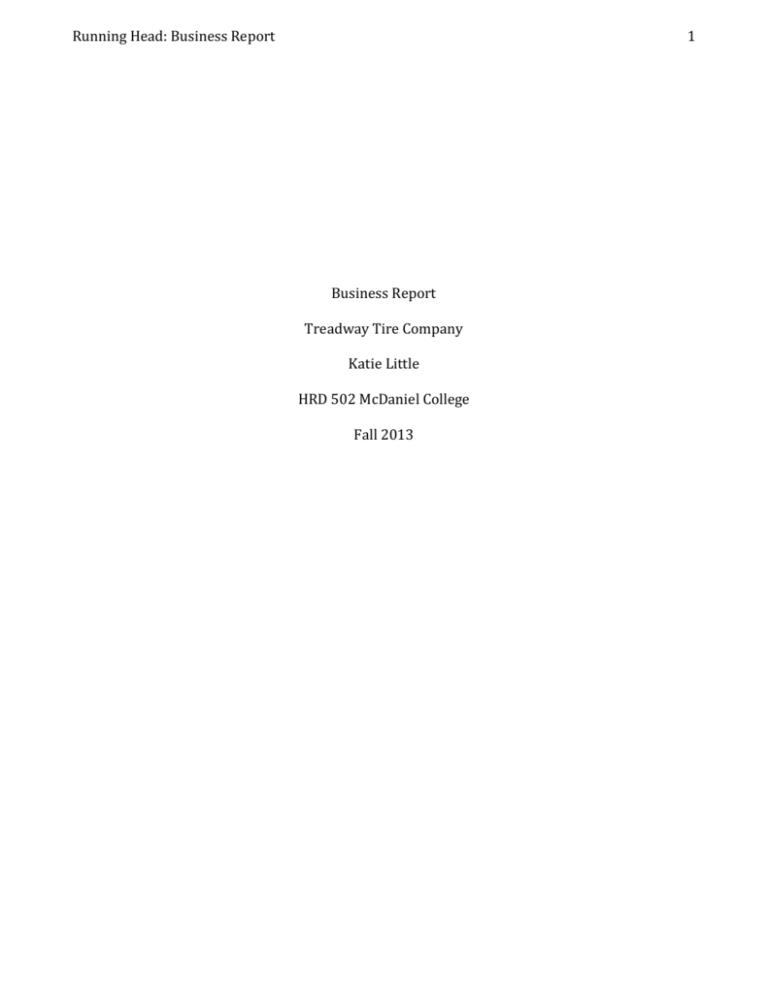
1 Running Head: Business Report Business Report Treadway Tire Company Katie Little HRD 502 McDaniel College Fall 2013 Running Head: Business Report 2 Background At the Treadway Tire Company, specifically the Lima Tire Plant, there was a high level of job dissatisfaction and turnover. Ashley Wall, a seasoned Human Resources professional, was faced with the challenge of creating a solution to the many problems at the plant before they reopened in January after a Christmas break. A large focus of her analysis was looking at the Foreman job position and how this affected the performance of the company. The Lima Tire Plant is one of eight plants operated by the Treadway Tire Company. The company was faced with many challenges in recent years such as rising raw material costs, competition, and the rising costs of oil. For Wall as a Human Resources professional she could help cut costs and improve productivity at the plant by reducing turnover. Case Study Findings To understand the changes that needed to be made Wall first had to understand the current working of the Lima Tire Plant. In 2007 the plant produced 25,000 truck tires per day and the plant itself was made of a building that was over 1.5 million square feet on 128 acres of land. There were 1,120 employees made of 970 hourly and 150 salaried. Those workers who were hourly were unionized. Of the salaried employees 50 were line foremen, 13 were general supervisors, and there was one plant manager. The Lima Plant had gone through a $100 million dollar expansion in 2000 that allowed the plant to increase its capacity and use new manufacturing technology. This all allowed the plant to become one of Treadway’s top plants in productivity and quality ratings. However, due to the closing of other plants in 2006 the Lima Plant was responsible for more volume. The shifts switched to continuous operations and worked 24 hours a day with four rotating shifts. Most employees work 12hour shifts instead of the previous 8-hour shifts and this helped reduce costs. The focus of the investigation done by Wall was on the foreman employees, this group made up the largest group of salaried employees. A large finding of the investigation was that the educational background and skill sets of foreman were two most important factors on their performance. Human Resources looked at the staffing of foreman critically, a majority came from internal promotions and the rest from young graduates or transfers. Wall was quoted as saying “although I agree with Treadway headquarters that we need to increase the percentage of college graduates and inter-company transfers, I personally feel that over the next two years, a realistic goal would be 60% internal hires, 30% new college graduates, and 10% company transfers,” (Skinner, 2008). What stands out most about the Line Foreman experience is the challenges that those employees faced to be successful. Foremen were expected to handle a variety of responsibilities during their 12-hour shift while still making sure that their production levels were up to expectations. Foremen had to make sure there were no technical issues that would stop production during the day prior to the start of their workday. However, when problems arose, such as hourly workers calling in sick or late, they would have to scramble to cover their workers. On top of these responsibilities they had to maintain safety and health standards, union and administrative duties, and disciplinary actions. Morale, hiring, and training were the three areas of the foreman job that needed the most attention. The morale of foreman was down, this was evident from exit interviews that showed high levels of discontent. Hiring practices of foreman was typically based on hourly employees interest in the foreman position. Those who expressed interest were given as First Line Test that consisted on many parts testing the knowledge of the candidate. To recruit those with college degrees they advertised at career fairs and online. Training of foreman was informal and most of the learning took place while on the job from trial and error. Wall believed that enhanced training would be the key to reducing the turnover rate among foremen; this could be by implementing a training program where foreman learned different tools that would help them be successful. Impact/Importance Running Head: Business Report 3 The success and morale of the foreman was highly important to the success of the Lima Tire Plant. The foremen are large part of what keeps the plant running smoothly on a daily basis. This means that equipping the foreman to be able to do their job to their best ability is important. If those in the foreman position are trained properly and stay in their job long enough to be successful this means that when there are opportunities for promotion that there are more qualified candidates. It was important for the Treadway Tire Company to look at how the Lima Tire Plant was functioning due to the change in how much productivity was demanded out of the plant. With recent closings and cost cutting the plant needs to be run high efficiently. Cutting turnover and decreasing job satisfaction would improve the way the plant functions. Recommended Course of Action There needs to be several changes made at the Lima Tire Plant in order for it to run more efficiently and remain successful. The main change that needs to be made is the implementation of an organized training program for those moving into and currently in the foreman position. By having those employees go through a more formalized training process it would eliminate the sink or swim mentality taken to new foreman on the job. The training program should emphasize plant operations, union work, disciplinary actions, and opportunities for education/advancement. Developing management should be a main concern for the Treadway Tire Company and the Human Resources professional at the Lima Tire Plant. Managers need high skill levels in “recognizing and accepting people’s individual behavioral differences, verbal and nonverbal communication, and conflict management,” (SHRM, 2013). Having well developed managers can play a main role in the organization’s success. The foremen at the plant were overwhelmed with stress and their daily duties, leading to high turnover and high dissatisfaction. The foreman can have a major impact on employee performance and revitalizing unmotivated employees. When developing the plan for how to develop the foreman there needs to be some strategic steps taken in order to be successful. First there needs to be an assessment of the existing managers skills levels, this will help know what areas need the most work. By doing training needs assessments those in Human Resources can develop personalized and group plants to fit the needs. Knowledge training in areas such as finance, administration, and union laws would all be high important for the foreman to be successful. Furthermore, training that can be done once an employee is already on the job could be skills like interviewing and performance management. In combination to a more organized training program it would be beneficial to create a new hiring and onboarding process for all employees. A standard needs to be set for how employees are trained so that operations are conducted consistently. This would not only help the foremen manage better but this would reduce costs from turnover or mistakes made in production due to a lack of training. In onboarding it would also be critical to emphasize the culture the company wants to maintain, there needs to a working atmosphere where there is respect and open lines of communication. With respect for coworkers and having open lines of communications it would help decrease problems between and employees so that they could focus more on production. Justification The recommendations proposed would help the efficiency at the Lima Tire Plant while also helping address their main two problems: high turnover and job dissatisfaction. Most of the needed changes are focused around the foreman position because that is where the most growth and impact can be made by implementing some needed programs. Having well-trained and prepared foreman can help keep the daily production at the plant run smoothly while also preparing them to take on any challenges that are presented. Foreman being well trained when hired and continuing training during their employment makes them more dedicated to the organization and keeps their morale up. The programs would not have outrageous costs associated with them and in the long run would help reduce costs from turnover and low morale. Running Head: Business Report References SHRM. (2013, March 03). Developing management. Retrieved from http://www.shrm.org/TemplatesTools/Toolkits/Pages/DevelopingManagement.aspx Skinner, C. Wickham, & Beckham, Heather. (2008). Treadway Tire Company: Job Dissatisfaction and High Turnover at the Lima Plant. Harvard Business School Cases 4

